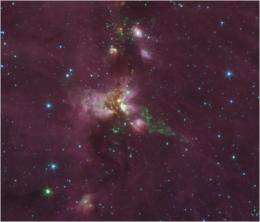An infrared image of the DR21 outflow region as seen by the Spitzer Space Telescope. New observations study the water in this outflow as well as in the dark gas clouds. Credit: NASA, Spitzer, Smith & Hora
Water is critical to human life, but also plays an important role in the life of stars and their planetary systems. As a gas, water helps to cool collapsing clouds of interstellar material so that they can form new stars.
In the form of ice, water acts as a glue on dust grains to help them coagulate into planetesimals and then into planets around the new stars. Finally, liquid water transports molecules on planetary surfaces, helping bring them together for complex chemistry.
Astronomers are actively looking for water in the cosmos, measuring its abundance, temperature and other properties, and trying to understand why it is found in some places but not others. In 1998, a NASA team led by SAO astronomers launched a space mission to study water in space, the Submillimeter Wave Astronomy Satellite (SWAS). SWAS found water nearly everywhere it looked, but also found a puzzle: there was less of it (in relation to other molecules) than had been expected. One proposed solution was that considerable amounts of water are frozen out onto the surfaces of cold grains of dust.
SAO astronomers Gary Melnick and Tim van Kempen were members of a large team who used the Herschel Space Observatory to study water around young, high mass stars. Herschel has much finer spatial resolution than did SWAS, and so is better able to distinguish the locations of the water in the complex regions around massive young stars that typically include dense central cores, outflows, and also foreground molecular clouds.
Their first paper on this program, about a young star in the constellation of Cygnus, reports that the water abundance in the cold core around the star is very low, supporting the idea that much of it is frozen as ice, and that the associated outflow (which has dust warmed to over 200 degrees kelvin) contains more than a thousand times as much water. The results are the first in series expected to refine our understanding of the roles water plays in star and planet formation.
Provided by Harvard-Smithsonian Center for Astrophysics























